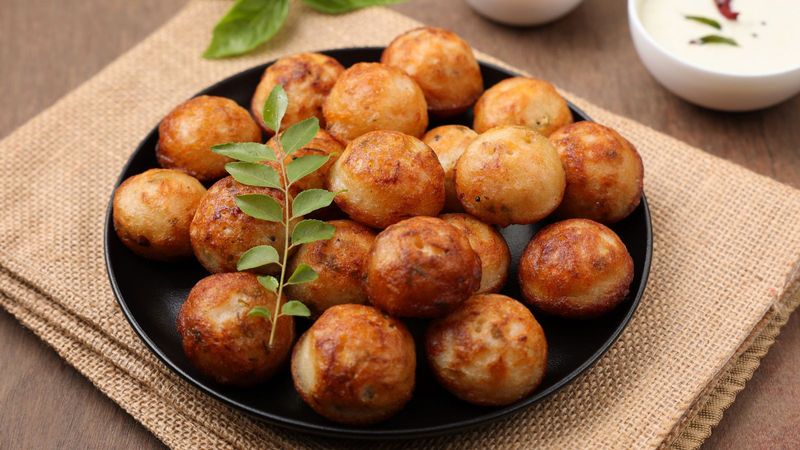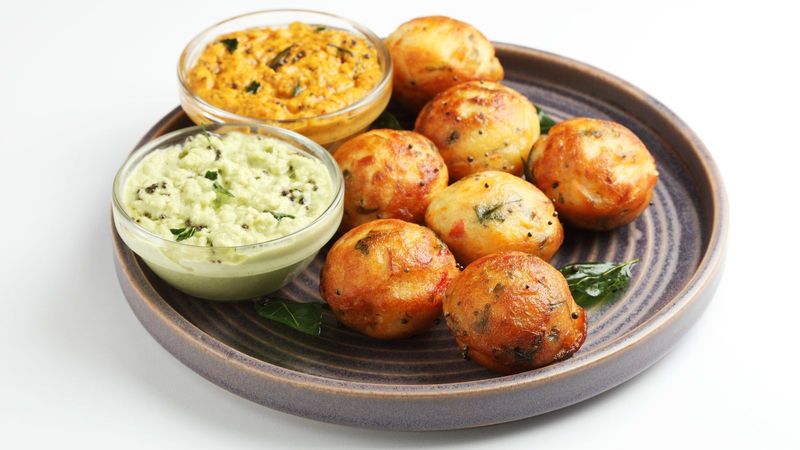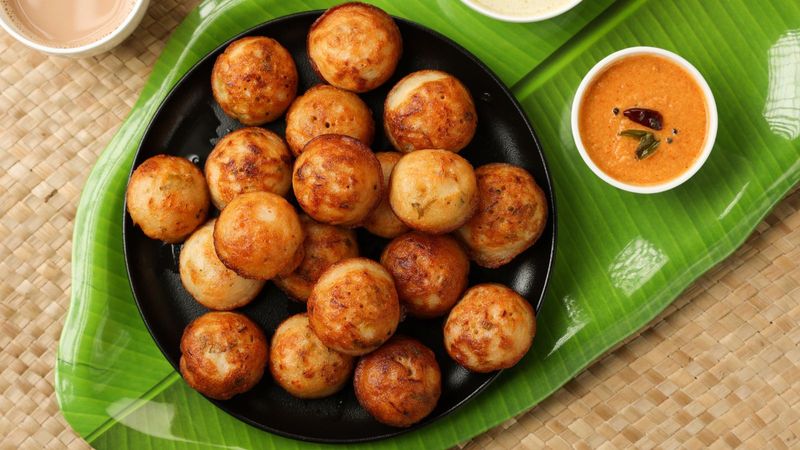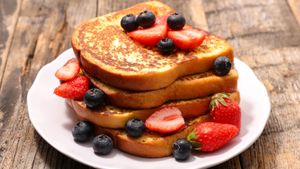We all love to snack on the pillowy soft paniyaram with a crispy exterior but sometimes struggle to get the perfect paniyaram batter and texture as our mothers and grandmothers. With this traditional Chettinad kuzhi paniyaram recipe, you can now recreate the magic of your mother’s kitchen by following simple instructions.
What is chettinad kuzhi paniyaram?
Kuzhi Paniyaram is a snack preparation from Tamil Nadu’s Chettinad region, famous for its masalas and variety of food. The Chettiars are known to use intense ground spices in their curries and vegetable preparations with balancing elements like coconut, yoghurt or buttermilk, creating a range of utterly flavourful, aromatic dishes. Of these recipes, the kuzhi paniyaram or kara paniyaram is a gift from the Chettiars to the rest of India. Served with coconut or tomato chutney, the kuzhi paniyaram are made using a specially moulded iron skillet, only slightly similar to idlis. While the paniyaram batter is mainly made of rice and urad dal as the key ingredients, it’s the paniyaram masala which goes into this batter that lends the kuzhi paniyaram its distinctive flavour.
Kuzhi paniyaram ingredients

To make paniyaram batter
- 1 cup uncooked rice
- ¼ cup urad dal
- ½ tsp methi seeds
- ½ tsp salt
- Water
For Paniyaram tempering
- 2 tsp oil
- 1 tsp urad dal
- 1 ½ tsp chana dal
- 1 tsp mustard seeds
- 1 tsp cumin seeds
- ½ tsp asafoetida
- 1 ½ inches ginger, chopped
- 2 green chillies, chopped
- 1 onion, chopped
- ½ tsp salt
- 4-6 curry leaves
- 2 tbsp curry leaves
- Chopped coriander leaves
- Water
- Oil
Kuzhi paniyaram recipe

- Soak rice in water for 3 hours. Soak urad dal and fenugreek seeds in water for 3 hours.
- After 3 hours, strain off the excess water and grind the soaked rice along with dal into a smooth batter by adding a little water at a time.
- Transfer the batter to a large bowl, mix in a little water, and ferment for at least 8 hours.
- Add oil to a hot pan. Once the oil is hot, add chana dal, urad dal, mustard seeds, and cumin seeds.
- Once the mustard seeds start splattering, add hing, chopped ginger, green chillies, and onions, and curry leaves.
- Reduce the flame, add the grated coconut and coriander leaves, and mix well.
- Add this tempering to the fermented paniyaram batter. Mix well and add water if the batter is too thick. Season as required, and your batter is ready.
- Heat a paniyaram skillet and apply oil to the moulds. You will need about a teaspoon of oil in each mould.
- Gently drop the paniyaram batter into the moulds and cook until the bottom side is fully golden brown. Be careful not to fill the mould up to the brim as the batter will rise slightly when it cooks.
- Flip them to the other side and cook until golden brown. Once cooked on both sides, remove the paniyarams from the skillet and transfer to a bowl.
- Serve the Chettinad Kuzhi Paniyarams hot with coconut or tomato chutney.
Cooking tips for the best chettinad kuzhi paniyaram

1. Which oil should we use for making the paniyaram and paniyaram masala?
Kuzhi Paniyaram does not require a lot of oil as it is not deep fried. In this kuzhi paniyaram recipe, you need just a teaspoon of oil in every mould while cooking paniyaram, and a few more teaspoons for making the paniyaram masala or tempering. Therefore, you can use any oil of your choice. However, traditionally it is made using gingelly oil which is derived from sesame seeds. For the traditional taste and flavour, we suggest you try making kuzhi paniyaram using gingelly or sesame oil.
2. How to ensure we get light and fluffy paniyaram upon cooking?
The secret to perfectly light and fluffy paniyaram lies in fermenting the batter correctly. For this, you must allow 3 hours of soaking time for rice, urad dal and the fenugreek seeds. More importantly, the ground kuzhi paniyaram batter must ferment for a minimum of 8 hours. If you live in places with relatively cooler climatic conditions, this might take longer. Try keeping the batter to ferment in warm spots in your house to mitigate this. If the batter has not fermented properly, the paniyaram in your skillet will turn out to be somewhat flat, not well-risen and fluffy.
This kuzhi paniyaram recipe is not only a great way to explore traditional Chettinad cuisine but also a rewarding experience as the result is irresistible. Thank us later, because once you taste Chettinad kuzhi paniyaram, you will find yourself making this easy, yummy paniyaram recipe over and over again.




